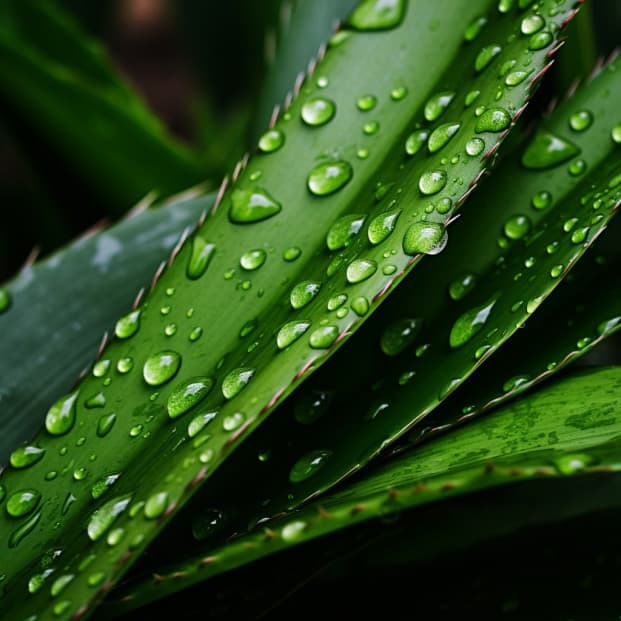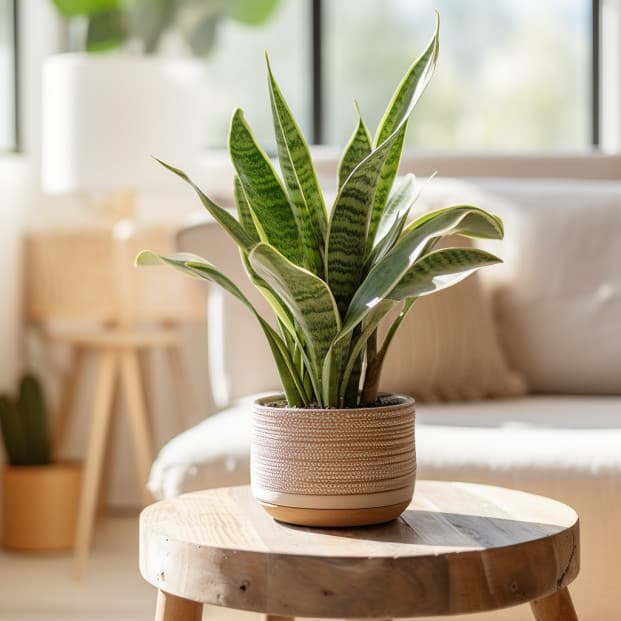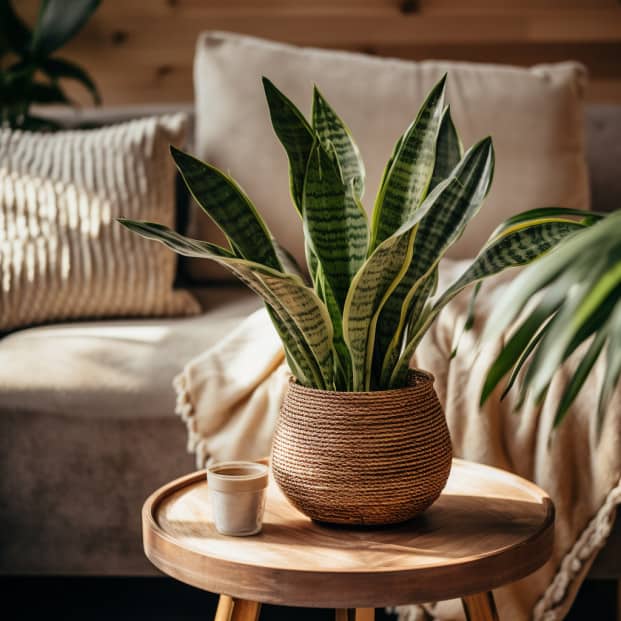According to expert botanist Linda, “Snake plants can emit a foul odor when overwatered.”
Ah, the familiar funk arising from your snake plant’s soil.
Rest assured, curious reader, a quick diagnosis will soon explain the stench.
First, understand that despite their sturdy constitution, these plants require little water to thrive.
Too much moisture invites decay, upsetting their sensitive roots.
Of course, snake plants aren’t alone in their distaste for damp conditions.
Many popular houseplants equally abhor soggy soil.
But armed with this simple knowledge, you can easily revive your snake plant…
… and banish the smell for good.
KEY TAKEAWAY
A smelly snake plant is often a result of overwatering or root rot, which can be addressed through proper care and preventive measures, ensuring a healthier and odor-free plant.
Why Does My Snake Plant Smell?
Have you noticed an unpleasant odor coming from your snake plant lately?
If so, it’s likely suffering from root rot caused by OVERWATERING. (1)
A healthy snake plant shouldn’t smell much at all.
But when the roots are constantly soaked in water, it creates the perfect environment for root rot to set in.
Rotting roots produce FUNKY GASES that make the whole plant smell.
The SOGGY SOIL also breeds bad bacteria and FUNGI that cause the rot and make the smell EVEN WORSE.
Soon your snake plant’s pot will reek!
In addition to smell, some other signs that point to root rot from overwatering include:
- WILTED, SOFT leaves that just don’t perk back up
- YELLOWING or BROWNING leaves that may even FALL OFF
- SHRIVELING stems
- SOGGY, MUSHY roots
If left untreated, the rot can damage the plant so much it may not recover.
But don’t worry, with the right care you can usually SAVE AN OVERWATERED SNAKE PLANT.
Here are the tips to fix smelly snake plant:
1. Remove and Inspect the Roots
Take the plant out of the pot and gently remove the soil.
CHECK THE ROOTS for any black, mushy, rotten sections.
TRIM THEM OFF with sterile pruning shears.
This removes the source of the smell.
2. Repot in Well-Draining Soil
Replant into fresh, loosely packed potting mix with GOOD DRAINAGE.
Commercial “potting soil” works, or make your own mix of 1 part each potting soil, perlite or gravel, and sand.
The gravel and sand improve AERATION and DRAINAGE.
3. Adjust Your Watering Habits
Going forward, only water when the top few inches of soil is COMPLETELY DRY.
Snake plants are experts at holding moisture, so they only need water every FEW WEEKS.
The new well-draining soil and less frequent watering will prevent overwatering and root rot from recurring.
With these TIPS, your smelly snake plant should perk back up within a few weeks once the roots are healthy again.
Just be patient and don’t overwater! A happy snake plant won’t stink up your home.
Root Rot and Its Impact on Snake Plant Odor

Have you noticed an unpleasant SMELL wafting from your snake plant lately?
Chances are it’s suffering from root rot due to EXCESS MOISTURE. (2)
Root rot is a COMMON fungal or bacterial infection that affects the ROOTS of overwatered plants.
It occurs when the soil stays continuously SOGGY, depriving roots of oxygen.
The lack of airflow and excess moisture create the perfect breeding ground for fungi and bacteria.
When root rot sets in, the plant’s roots begin ROTTING and PRODUCING FUNKY GASES.
These gases are what cause the FOUL ODOR.
As the rot worsens, the smell gets progressively STRONGER.
The SOGGY SOIL also harbors microbes that intensify the stench.
Some signs that root rot may be to blame for your snake plant’s SMELL include:
- FOUL ODOR from the soil or whole plant
- BLACK, SOFT or MUSHY roots
- LEAF DROOPING or YELLOWING
- BROWN or SOFT SPOTS on leaves
- WHITE FUNGAL GROWTH on soil
To save an infected snake plant, remove it from the pot.
Cut away any ROTTEN ROOTS using sterile shears.
Repot in fresh, well-draining soil and space plants to allow AIRFLOW between them.
Avoid watering until the soil is completely DRY.
Maintaining GOOD DRAINAGE is key to preventing root rot and its stinky side effects! With time and care, your snake plant should recover.
Identifying the Causes of Unpleasant Odors in Snake Plants
Snake plants are popular houseplants known for being tough and resilient. But sometimes you might notice a foul, unpleasant smell coming from your snake plant.
This is often a sign of an underlying issue.
The most common causes of bad odors in snake plants are:
- Overwatering – Wet, soggy soil leads to root rot. The decaying roots give off smelly gases.
- Poor drainage – Waterlogged soil causes root rot. Be sure the pot has drainage holes.
- Pest infestations – Bugs like fungus gnats can cause odors as they eat away roots.
- Bacterial or fungal diseases – Overwatering encourages growth of harmful bacteria and fungi.
- Old potting mix – Smelly, mucky old soil should be replaced to refresh the plant.
- Dead roots or leaves – Remove any dead or dying plant parts which can smell bad.
The best way to keep your snake plant smelling fresh is to provide proper care.
Water only when the top several inches of soil are dry. Ensure the pot has drainage holes to prevent waterlogging. Give bright, indirect light to encourage growth. And repot in fresh soil every 2-3 years.
How to Save Smelly Snake Plant

If your snake plant has an unpleasant odor, don’t worry!
With some troubleshooting and care, you can likely save it and restore its fresh scent.
Tools you will need:
Steps you must take:
Step 1. Remove the plant from its pot and inspect the roots and soil. Cut off any black, mushy roots.
Step 2. Wash the remaining healthy roots gently with water to remove old soil. Allow roots to dry before repotting.
Step 3. Discard old potting mix and clean the pot thoroughly. Repot in fresh, well-draining soil.
Step 4. Water the freshly repotted plant only when soil is completely dry. Provide bright, indirect light.
Step 5. Be patient! It may take several weeks for new roots to grow and the bad smell to diminish.
Step 6. Consider propagating healthy leaves in water as insurance if the main plant dies.
Step 7. Once snake plant is recovering and smells fresh, resume normal care, allowing soil to dry out between waterings.
With some TLC and improved drainage, your smelly snake plant can make a full recovery!
Just be sure to identify and address the underlying overwatering issue.
Snake Plant Flowering: A Potential Source of Odors
Seeing snake plant flowers emerge can be exciting.
But did you know these blooms can sometimes cause unpleasant smells?
Snake plants bloom by sending up a tall stalk from the center of the plant.
The stalk grows tiny white flowers that have a strong, pungent scent.
This odor helps attract pollinators. But some may find it foul or unpleasant, especially indoors.
The flowering stalk will eventually die back on its own.
Here are some tips to manage the smell:
- Prune off the stalk once flowers fade to prevent odor.
- Move plant away from high traffic areas while blooming.
- Improve air circulation near the plant to dissipate smells.
- Mist the flowers gently to mask some of the scent.
- Be patient – flowering only lasts a couple weeks.
Enjoy your snake plant’s blooms, but don’t be surprised if you notice some new smells during this time!
The odor should resolve on its own as flowers dry up and the stalk dies back.
Reviving a Dying Snake Plant: Steps to Rescue a Troubled Plant

If your snake plant is struggling and dying, don’t give up on it yet! With some TLC, you may be able to nurse it back to health.
Step 1. Remove plant from pot and inspect roots for rot. Trim any mushy roots.
Step 2. Repot in fresh soil, ensuring the pot has drainage holes.
Step 3. Move plant to a bright spot, but avoid direct sun.
Step 4. Allow soil to dry out completely before watering again.
Step 5. Wipe leaves with damp cloth to remove dust and pests.
Step 6. Apply liquid fertilizer diluted to 1/4 strength every few weeks.
Step 7. Propagate healthy leaves in water as a backup.
Step 8. Be patient! It can take weeks or months to rejuvenate.
Step 9. Resume normal care once plant improves, allowing soil to dry out between waterings.
Don’t give up too soon on a struggling snake plant.
With some troubleshooting and extra care, there’s a good chance you can nurse it back to health!
Just be sure to identify and fix any underlying issues, like overwatering, and give it time to bounce back.
Post-Repotting Check
After repotting your snake plant in fresh soil, be sure to keep a close eye on it over the next few weeks. Here’s what to look out for:
- Check for new root growth. Gently remove plant and inspect roots. Look for healthy white tips.
- Watch for signs of transplant shock like drooping or yellowing leaves. This is normal at first.
- Feel soil to ensure it’s drying out. Adjust watering accordingly.
- Look under leaves and in soil for any pests like fungus gnats. Treat if needed.
- Consider using a stake or trellis if plant is unstable or drooping in new pot.
- Wipe leaves with damp cloth to remove dust from repotting.
- Give plant bright indirect light to encourage recovery after repotting.
Closely monitoring your snake plant after repotting with clean pot helps ensure it adjusts well without any major setbacks.
If any issues arise, you can catch them early.
Prevention Tips
Here are some tips to help prevent common snake plant problems like smelly odors in the future:
- Allow soil to dry out between waterings. Never let sit in soggy soil.
- Ensure pot has drainage holes to prevent waterlogging.
- Repot every 2-3 years in fresh, sterile soil to stop salts and odor buildup.
- Propagate new plants to keep a healthy supply going.
- Inspect leaves and roots periodically for pest damage or rot.
- Provide bright, indirect light to encourage growth and air circulation.
- Consider using terra cotta pots which naturally dry out soil faster.
- Be careful not to over fertilize, which can damage roots.
- Remove dead leaves and flowers to prevent fungal growth.
With proper care and conditions, you can avoid many common issues with snake plants.
But if problems do arise, address them promptly to restore plant health.
Frequently Asked Questions
1. What causes the unpleasant odor in my snake plant?
The odor in your snake plant (mother in law tongue) can result from several factors, including potting soil, overwatering, and root rot.
2. How do I identify overwatered snake plant symptoms?
Overwatered snake plants may exhibit signs such as mushy leaves, yellowing of leaves, and a rotting smell.
3. What is the impact of root rot on snake plant odor?
Root rot can lead to a foul smell in snake plants as it affects the root system, making the plant susceptible to disease.
4. How can I save an overwatered snake plant?
To rescue your overwatered snake plant, consider repotting in well-draining soil, providing bright indirect light, and adjusting your watering habits.
5. What is the best way to care for my snake plant to prevent root rot and odors?
Proper snake plant care includes using well-draining potting soil, avoiding overwatering, and ensuring your plant gets bright indirect light.
6. How can I clean the pot to prevent odors in my snake plant?
Cleaning the pot with mild soap and water can help eliminate odors and prevent root rot.
7. Can snake plants bloom, and do the flowers contribute to the odor?
Yes, snake plants can produce flowers, but their flowers are usually small and don’t significantly contribute to the plant’s odor.
8. How can I prevent root rot in snake plants?
To prevent root rot, ensure that your snake plant is potted in well-draining soil and avoid overwatering.
9. What is the ideal soil moisture for a healthy snake plant?
Maintaining moderately moist soil is essential for a healthy plant. Avoid letting the soil become too dry or too wet.
10. How can I propagate my snake plant?
You can propagate snake plants through leaf cuttings or division during the growing season.
11. Are there common pests like spider mites that can cause odors in snake plants?
Yes, pests like spider mites can affect snake plants and potentially lead to unpleasant odors.
12. What should I do if my snake plant leaves turning yellow?
Yellowing leaves could be a sign of overwatering or poor soil drainage. Adjust your watering habits and repot if needed.
13. Can snake plants become root-bound, and how does it affect odor?
Snake plants can become root bound if not repotted. This may lead to an unpleasant odor due to limited space for the root system.
14. How can I grow and care for snake plant flowers?
Caring for snake plant flowers involves providing the plant with adequate light and maintaining proper soil moisture.
15. Is snake plant care suitable for container gardening?
Yes, snake plants thrive in containers, making them an excellent choice for container gardening.
Conclusion
In conclusion, being attuned to your snake plant’s natural or changing odors can help you address minor troubles before they escalate.
An odd scent may signal the need for improved drainage, root pruning or attention to potential pests.
Remember – snake plants are tough, but even they appreciate TLC, which is why they need grow and care from you.
If you have any other questions, please don’t hesitate to comment below!
I’d be happy to help with caring for your snake plant and ensuring many years of stink-free happiness.
References
- https://planterhoma.com/blogs/planting-tricks-tips/fix-overwatered-snake-plant#:~:text=Overwatering%20can%20be%20detrimental%20to,to%20root%20rot%20if%20overwatered.
- https://www.thespruce.com/snake-plant-care-overview-1902772#:~:text=Common%20Problems%20With%20Snake%20Plant&text=When%20soil%20develops%20a%20foul,healthy%20portion%20of%20the%20rhizome.
Related Articles
- https://allthingsgardener.com/causes-of-root-rot-in-snake-plant/
- https://allthingsgardener.com/potting-soil-smells-bad/
- https://allthingsgardener.com/save-dying-snake-plant-is-possible-to-do/


